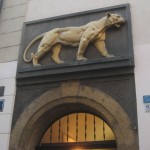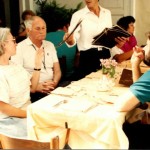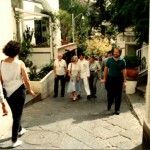Interview with the founder Sandro Ferri. Edizioni e/o celebrates the centenary of Bohumil Hrabal with a new edition of all his works
At the time, we did not have the contacts we have today. There were no low costs, online booksellers, single currencies, painstaking translators and devastating mass tourism. For those who really wanted to pass the “limes Sovieticus”, the only consolation was the huge mugs of Czech beer, maybe in the famous smoky pubs, “At the Golden Tiger” or “At the Ostrich”. During the early nineteen-eighties, Prague was a rather run down and sceptical city, though it was still an active frontier of the sleepy Brezhnev communist period.
A spectral city and one of silent cries that could, at times, still evoke the Golem ghosts and the descriptions of Leo Perutz, the pulsating heart of Central Europe – to which the “valium”, administered by president Gustáv Husák (and by the threat imposed by the Russian tanks), had really torn apart the heart and soul of the people.
Only few were the brave and enthusiasts who had decided to reach this place and delve into Czech culture so as to better understand the “magical” city with the still rather mysterious names: Egon Bondy, Jaroslav Seifert, Jiří Kolář, and even Karel Teige, Egon Erwin Kisch and so on.
One of these hardy pioneers was Sandro Ferri, from Rome, the founder in 1979 – together with his wife Sandra Ozzola – of the famous publishing house Edizioni e/o.
E/o stands for “Eastern Europe” and has become a successful editorial name with publications by authors, such as Jean-Claude Izzo, Massimo Carlotto and bestseller Muriel Barbery, including great writers from all over the world. But 40 years ago, it was just a pioneer publishing house, whose aim was to discover writers from the East, particularly Czechs: “It all started a bit by chance – explains Ferri. We had a bookshop in the heart of Rome which was called “The Old Mole”, a reference point for many left-wing intellectuals. There was a certain air of openness and the desire to understand what went on beyond the wall. Little was known about dissidence and probably even less about the social and cultural life of these countries. But we were keen to discover things, even if it meant walking on unexplored territory. The reference books available were very few, because there were few scholars then – now called Bohemists and Slavicists. We strongly wanted to fill up this enormous cultural black hole – Ferri went on to say. However, the only distinguished name in the bohemistic field was Angelo Maria Ripellino, helped by his wife. Ripellino had opened the way and we continued along that road, that was metaphorically speaking, still a trail. It was also Ripellino that informed us of a Czech expatriate living in Paris, called Milan Kundera: so we thought that he might be the right man for our project.
 It was in fact in 1979, that Kundera published a series of articles, in a few French magazines, on the value of Central European culture in the Europe of peoples, that provoked much discussion. Intrigued by this fact, we got in touch with him and decided to start the new publications with a “Prague series”, that was directed by Milan Kundera himself”.
It was in fact in 1979, that Kundera published a series of articles, in a few French magazines, on the value of Central European culture in the Europe of peoples, that provoked much discussion. Intrigued by this fact, we got in touch with him and decided to start the new publications with a “Prague series”, that was directed by Milan Kundera himself”.
- Twice pioneers, then, in your choice of the series and its curator.
“I would also add the graphics. Encouraged by Milan, we were able to recover a few old notebooks that were in fashion in Prague in the 1930s. This led to the “e/o style” that made us immediately recognizable by our book covers and the style of our texts. And, also largely thanks to our creative graphic designer, Sergio Vezzali: he took the notebooks that we had found in Prague and enhanced the pictures. For the book covers of the “Closely watched trains”, for example, he used small “pasta wheels”, that were then photographed and made smaller. It was also important to give our readers a sort of retro taste of Prague at the time: that was a little bit Czech, Jewish and also German…”
- What advice did you get from Kundera?
“He had clear ideas and bet on Hrabal, to whom he added Nezval and Brod, that is: the protagonists of the “Prague circle”. Kundera had understood that you could work on “dissent literature”, without forgetting the great figures of the Beneš Czechoslovak Republic, the great writers of the nineteen-thirties… A treasure chest that had never been opened, full of precious works”.
- Was he responsible for putting you in touch with Hrabal?
“Yes, it was Kundera, himself. It must have been 1980 or 1981. We arrived in the city of Prague, that looked spectral. The appointment was in a pub, where Hrabal often met up with his group of followers and pub mates. Maybe it was “At the Golden Tiger” or perhaps at the “U Hinků”. He left us standing in awkward silence for about ten minutes, looking us up and down. Then, perhaps feeling reassured – only God knows by what – he allowed us to sit down. A rather rough approach, but a lucky one, I have to say. The innkeeper, a huge Moravian man, arrived and served us ice-cold beers while the diners pulled out some meat and cheese from their bags. An ideal way to get to know each other and to ease the situation”.
- A sort of Bohemien approach, you might say…
“But Hrabal maintained a degree of unpredictability, even though he was a famous writer and was well-known in the West. I remember that during his first Italian tour he was accompanied by one of his translators, Susanna Roth”. He met Federico Fellini, Giorgio Pressburger, Giovanni Giudici and many local intellectuals. He seemed quite satisfied but he was never quite “manageable”… Then at the Book Exhibition in Turin, he refused join the audience and remained in the car for almost two hours…”
- His Czech publisher was the Odeon. How did you start relations?
“Hrabal, like many other writers of that period, had two types of publications. Those accepted by the regime that you could find in bookshops – even if the regime “punished” him at times for his independence by interrupting his publication – and those that circulated with the samizdat. They were different texts and we worked mainly with the “semi-clandestine” editions.
- Hrabal’s works are full of irony against the established authority. So, what position did he maintain in relation to the communist government?
“He still considered himself a left-wing person, like many Czech intellectuals of the nineteen-seventies and eighties. But you should not confuse his position with that of other people, such as Havel, Pelikán or Kundera. Hrabal had already paid the consequences, but he was not an expat. Now, he preferred to maintain a rather more niche position, which was not so open to dispute but, which was at the same time, critical between the lines”.
- When did you realize about the success of “the Prague series”?
“Sales were slow at the beginning, but we deserve the merit for believing in what we were doing and for being consistent. Following the publication of “I served the King of England”, there were “Closely watched trains”, “Cutting it short” and “A tender barbarian”. When “Trains” became a film, we realized that we had guessed right and that our message had reached the Italian public”.
- For the Eastern Europe authors you passed from a so-called “niche” literature to an almost crowded number of titles of today. What is the reason for this?
“Perhaps this means that we were right, (he laughs…). In the sense that the literature of those countries (and not only the Czech Republic, but also Poland and Hungary, etc.) already had the right elements to attract or appeal to an Italian public. Of course, we cannot leave out the work done by Adelphi, Roberto Calasso and Bobi Bazlen, but I would say that even we contributed significantly”.
- Today, e/o is a well-established medium-large size publishing house with great writers and a large distribution. Among its many successes, there is also the American “New York editions”, started in 2005. However, the Czech writers that you publish are always the “usual” classic ones. Is that due to a lack of confidence in young writers?
“I would not say so. I can safely state that between Hrabal, Brod, and Kundera, himself, and maybe Viewegh, Petra Hůlová and other recent writers, there is quite a substantial difference. I think we have to face up to a period of transition, with other themes, other characters and History in order to find the great names of thirty years ago. It is not traditionalism, but simply an attempt to be realistic”.
by Ernesto Massimetti








